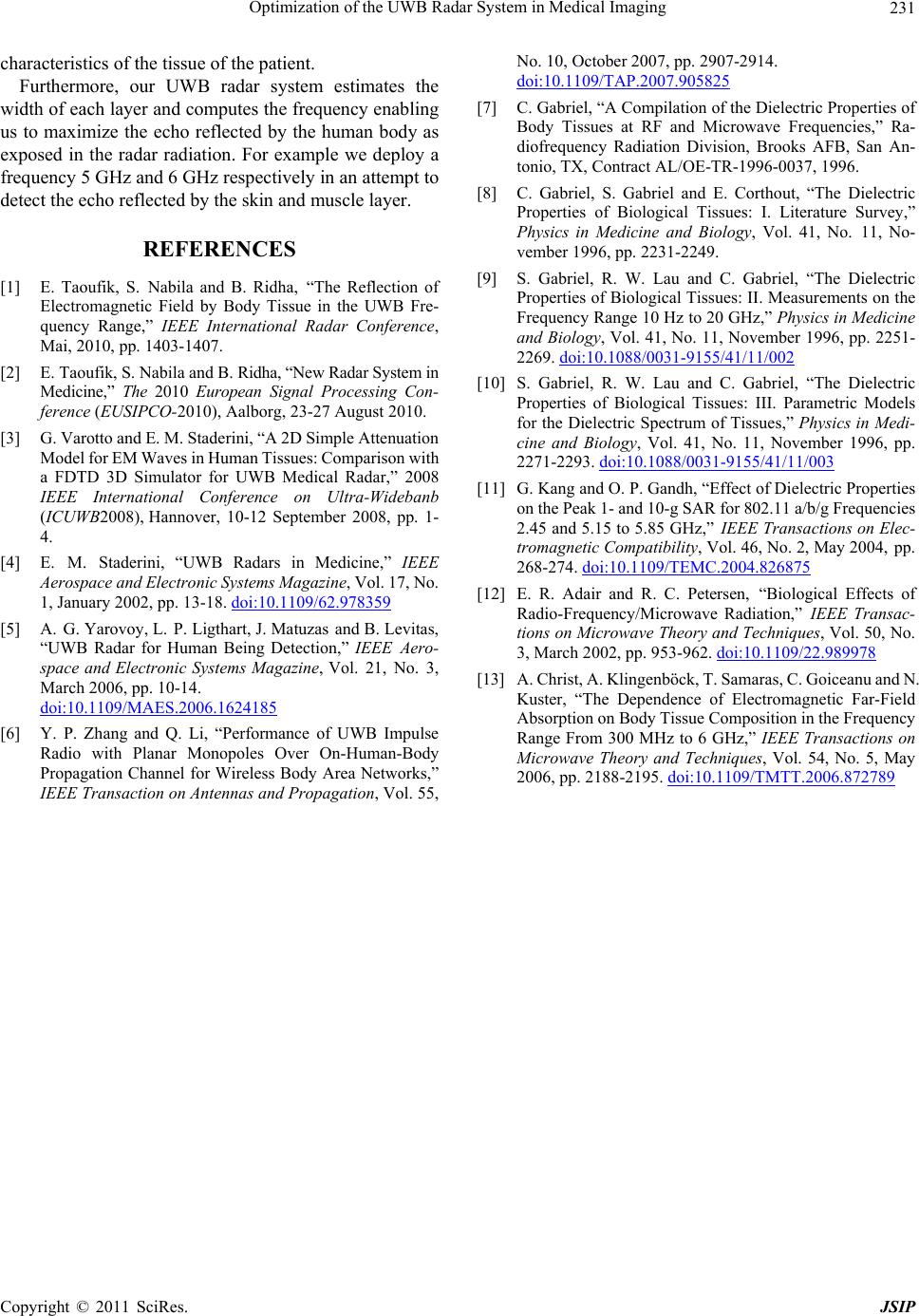
Optimization of the UWB Radar System in Medical Imaging
Copyright © 2011 SciRes. JSIP
231
characteristics of the tissue of the patient.
Furthermore, our UWB radar system estimates the
width of each layer and computes the frequency enabling
us to maximize the echo reflected by the human body as
exposed in the radar radiation. For example we deploy a
frequency 5 GHz and 6 GHz respectively in an attempt to
detect the echo reflected by the skin and muscle layer.
REFERENCES
[1] E. Taoufik, S. Nabila and B. Ridha, “The Reflection of
Electromagnetic Field by Body Tissue in the UWB Fre-
quency Range,” IEEE International Radar Conference,
Mai, 2010, pp. 1403-1407.
[2] E. Taoufik, S. Nabila and B. Ridha, “New Radar System in
Medicine,” The 2010 European Signal Processing Con-
ference (EUSIPCO-2010), Aalborg, 23-27 August 2010.
[3] G. Varotto and E. M. Staderini, “A 2D Simple Attenuation
Model for EM Waves in Human Tissues: Comparison with
a FDTD 3D Simulator for UWB Medical Radar,” 2008
IEEE International Conference on Ultra-Widebanb
(ICUWB2008), Hannover, 10-12 September 2008, pp. 1-
4.
[4] E. M. Staderini, “UWB Radars in Medicine,” IEEE
Aerospace and Electronic Systems Magazine, Vol. 17, No.
1, January 2002, pp. 13-18. doi:10.1109/62.978359
[5] A. G. Yarovoy, L. P. Ligthart, J. Matuzas and B. Levitas,
“UWB Radar for Human Being Detection,” IEEE Aero-
space and Electronic Systems Magazine, Vol. 21, No. 3,
March 2006, pp. 10-14.
doi:10.1109/MAES.2006.1624185
[6] Y. P. Zhang and Q. Li, “Performance of UWB Impulse
Radio with Planar Monopoles Over On-Human-Body
Propagation Channel for Wireless Body Area Networks,”
IEEE Transaction on Antennas and Propagation, Vol. 55,
No. 10, October 2007, pp. 2907-2914.
doi:10.1109/TAP.2007.905825
[7] C. Gabriel, “A Compilation of the Dielectric Properties of
Body Tissues at RF and Microwave Frequencies,” Ra-
diofrequency Radiation Division, Brooks AFB, San An-
tonio, TX, Contract AL/OE-TR-1996-0037, 1996.
[8] C. Gabriel, S. Gabriel and E. Corthout, “The Dielectric
Properties of Biological Tissues: I. Literature Survey,”
Physics in Medicine and Biology, Vol. 41, No. 11, No-
vember 1996, pp. 2231-2249.
[9] S. Gabriel, R. W. Lau and C. Gabriel, “The Dielectric
Properties of Biological Tissues: II. Measurements on the
Frequency Range 10 Hz to 20 GHz,” Physics in Medicine
and Biology, Vol. 41, No. 11, November 1996, pp. 2251-
2269. doi:10.1088/0031-9155/41/11/002
[10] S. Gabriel, R. W. Lau and C. Gabriel, “The Dielectric
Properties of Biological Tissues: III. Parametric Models
for the Dielectric Spectrum of Tissues,” Physics in Medi-
cine and Biology, Vol. 41, No. 11, November 1996, pp.
2271-2293. doi:10.1088/0031-9155/41/11/003
[11] G. Kang and O. P. Gandh, “Effect of Dielectric Properties
on the Peak 1- and 10-g SAR for 802.11 a/b/g Frequencies
2.45 and 5.15 to 5.85 GHz,” IEEE Transactions on Elec-
tromagnetic Compatibility, Vol. 46, No. 2, May 2004, pp.
268-274. doi:10.1109/TEMC.2004.826875
[12] E. R. Adair and R. C. Petersen, “Biological Effects of
Radio-Frequency/Microwave Radiation,” IEEE Transac-
tions on Microwave Theory and Techniques, Vol. 50, No.
3, March 2002, pp. 953-962. doi:10.1109/22.989978
[13] A. Christ, A. Klingenböck, T. Samaras, C. Goiceanu and N.
Kuster, “The Dependence of Electromagnetic Far-Field
Absorption on Body Tissue Composition in the Frequency
Range From 300 MHz to 6 GHz,” IEEE Transactions on
Microwave Theory and Techniques, Vol. 54, No. 5, May
2006, pp. 2188-2195. doi:10.1109/TMTT.2006.872789